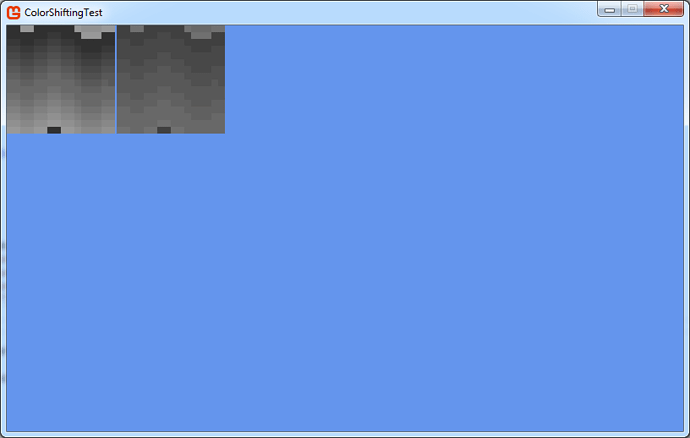I am attempting to do color cycling in a shader. Basically, I have an indexed texture (Texture) that has 14 unique grayscale colors and is 16x16. It looks like this: ![]()
These are the 14 grayscale colors:
48, 48, 48
56, 56, 56
64, 64, 64
72, 72, 72
80, 80, 80
88, 88, 88
96, 96, 96
104, 104, 104
112, 112, 112
120, 120, 120
128, 128, 128
136, 136, 136
144, 144, 144
152, 152, 152
I then have a 14x1 dimension color map texture (ColorMap) that I’m trying to index based on the previous texture. It also has those 14 unique grayscale colors. It looks like this: ![]()
This is my code for rendering the textures:
using Microsoft.Xna.Framework;
using Microsoft.Xna.Framework.Graphics;
namespace ColorShiftingTest
{
public class Game1 : Game
{
GraphicsDeviceManager graphics;
SpriteBatch spriteBatch;
Texture2D colorMap;
Texture2D texture;
Effect shiftEffect;
public Game1()
{
graphics = new GraphicsDeviceManager(this);
Content.RootDirectory = "Content";
}
protected override void LoadContent()
{
spriteBatch = new SpriteBatch(GraphicsDevice);
colorMap = Content.Load<Texture2D>("ColorMap");
texture = Content.Load<Texture2D>("Texture");
shiftEffect = Content.Load<Effect>("ColorShiftingEffect");
shiftEffect.Parameters["ColorMapTexture"].SetValue(colorMap);
}
protected override void Draw(GameTime gameTime)
{
GraphicsDevice.Clear(Color.CornflowerBlue);
var blendState = BlendState.NonPremultiplied;
var samplerState = SamplerState.PointClamp;
var renderSize = new Point(texture.Width * 8,
texture.Height * 8);
// rendered with no effect
spriteBatch.Begin(SpriteSortMode.FrontToBack, blendState, samplerState);
spriteBatch.Draw(texture,
new Rectangle(Point.Zero, renderSize),
Color.White);
spriteBatch.End();
// rendered with color shift effect
spriteBatch.Begin(SpriteSortMode.FrontToBack, blendState, samplerState,
null, null, shiftEffect);
spriteBatch.Draw(texture,
new Rectangle(new Point(130, 0),
renderSize),
Color.White);
spriteBatch.End();
base.Draw(gameTime);
}
}
}
And this is what my shader file ColorShiftingEffect looks like:
sampler2D Texture : register(s0);
sampler1D ColorMap = sampler_state
{
Texture = (ColorMapTexture);
Filter = POINT;
AddressU = WRAP;
AddressV = WRAP;
AddressW = WRAP;
};
struct out_vertex
{
float4 position : SV_POSITION;
float4 color : COLOR;
float2 texCoord : TEXCOORD0;
};
float4 main_fragment(in out_vertex VAR) : SV_TARGET
{
float4 c = tex2D(Texture, VAR.texCoord);
float4 t;
t = tex1D(ColorMap, c.r);
return t;
}
technique T0
{
pass P0
{
PixelShader = compile ps_5_0 main_fragment();
}
}
This is the output that I get, when I am expecting them both to be the same:
Is anyone able to help me get this working properly? If I haven’t explained something let me know and I’ll expand on it. The end effect I’m looking to achieve is this (when the proper color map is created):

You can also see an example of what I’m trying to do here: http://www.effectgames.com/demos/canvascycle/
